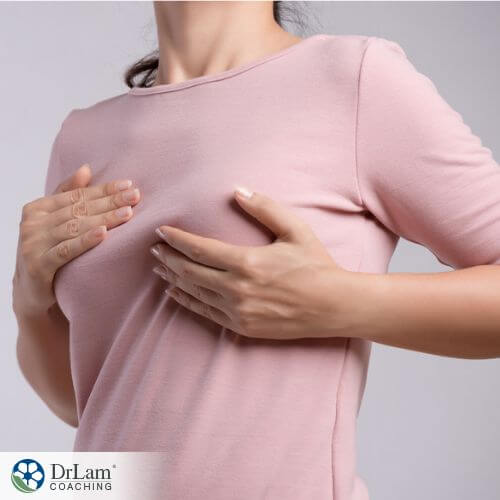 Changes occur in the breast from the time of adolescence all the way into menopause. Some of these changes are normal, and others can be irritating, painful, or indicate a more serious condition. As such, it’s important to know what a normal breast looks and feels like, how to perform a self-check breast exam, and when it’s necessary to visit your physician if you notice changes. This article covers breast health concerns, common breast problems, reducing the treatment-related effects of breast cancer, and the best supplements and habits to support breast health.
Changes occur in the breast from the time of adolescence all the way into menopause. Some of these changes are normal, and others can be irritating, painful, or indicate a more serious condition. As such, it’s important to know what a normal breast looks and feels like, how to perform a self-check breast exam, and when it’s necessary to visit your physician if you notice changes. This article covers breast health concerns, common breast problems, reducing the treatment-related effects of breast cancer, and the best supplements and habits to support breast health.
The main purpose of the breast is to facilitate lactation. Essentially, after the delivery of a baby, the breast creates milk for the baby. A single breast comprises roughly 25 to 20 lobes, containing the glands that produce milk. Also, it has ducts that take the milk to the breast nipples. Breast size has no bearing on the amount of milk produced by the breasts. In addition, breasts go through changes over time.
Hormonal changes impact breast tissue from the time of adolescence through to menopause. When hormonal levels change - as they do during the menstrual cycle, pregnancy, or lactation - breast tissue changes also tend to occur. Before and after menstruation, many women experience more breast tenderness or lumpiness.
Also, it’s not uncommon for the breasts to have lumps and non-cancerous nodules. Women typically have greater breast discomfort when transitioning from normal periods to their final periods during menopause. This is due to a shift in hormone levels that, in turn, impacts the breast tissue. Furthermore, following menopause, fatty tissue replaces the glandular breast tissue for the most part.
Your hormones control several different functions in your body. The Hormone Circuit of the NeuroEndoMetabolic (NEM) Stress Response plays a vital role in hormonal regulation. It is comprised of three essential organs: the adrenal glands, reproductive organs, and thyroid glands. These organs are involved in key bodily processes, such as metabolism, energy production, and reproduction. The NEM Stress Response is also key in how your body responds to stress.
Chronic stress can lead to hormone imbalance, which can affect these bodily functions and lead to health conditions. This happens because the adrenal glands share several key hormone precursors with the other components of the Hormone Circuit. When they produce large amounts of cortisol, the stress hormone, to deal with stress, they are unable to keep up with the demand for other key hormones. In such a case, Adrenal Fatigue Syndrome (AFS) can develop. Individuals with AFS tend to have an increased risk of multiple health issues, including potentially breast cancer, because of imbalances in the Hormone Circuit.
Painful breasts, or what is known as mastalgia, is the most common complaint related to breast health. There is still some mystery about the actual cause of this problem. However, there is usually some association between painful breasts and the menstrual cycle, particularly in younger females.
It’s commonly characterized by tenderness or pain in both breasts right before menstruation begins. Fluid retention linked to the menstrual cycle and hormonal changes is usually responsible for this occurrence.
However, this symptom can also happen in both perimenopausal and postmenopausal females. Additionally, in this instance, it’s not usually related to the menstrual cycle. As such, an assessment by your physician is important in order to determine the cause of the discomfort.
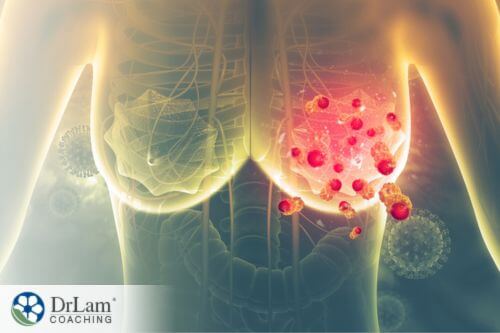 Breast cancer is a condition where the cells in the breasts grow abnormally. Even though there are various kinds of breast cancer, they typically originate in the milk ducts or the milk-producing glands. However, breast cancer can spread to surrounding tissues and other bodily organs. Breast cancer appears to affect women in their 50s more so than any other age group.
Breast cancer is a condition where the cells in the breasts grow abnormally. Even though there are various kinds of breast cancer, they typically originate in the milk ducts or the milk-producing glands. However, breast cancer can spread to surrounding tissues and other bodily organs. Breast cancer appears to affect women in their 50s more so than any other age group.
The primary risk factors linked to breast cancer include:
Only between 5-10% of breast cancers are linked to family history. Particularly, with one or more first-degree (e.g. parent) or second-degree (e.g. grandparent) relatives on either the maternal or paternal side of the family with breast cancer, your risk goes up. Around the same percentage of breast cancer develops in women whose families have a gene mutation that’s passed down through the family. This puts them at a greater risk of developing breast cancer.
Additional factors that can increase the risk of breast cancer include:
There is no absolute way to prevent breast cancer, so your risk will never be zero. However, you can lower your risk of getting breast cancer, particularly with certain lifestyle changes and routine breast exams. If any of the mentioned risk factors are of concern to you, speak to your physician about your breast health.
Some specific breast changes that can potentially signal breast cancer include:
If you are experiencing any of these changes, visit your physician for an assessment, and if needed, you may get a referral to a breast specialist. A breast exam, mammogram/ultrasound, or biopsy may be recommended by the specialist to determine if the symptoms are harmless or cancerous.
It’s best to start doing regular breast self-exams from the time you are in your 20s. Familiarizing yourself with the feel and look of your breasts can help you to recognize changes in them. You should do a breast self-exam once per month. Here’s how to perform these exams:
Position yourself in front of a mirror with your hands placed on your hips. Keep your shoulders straight. Pay close attention to the color, shape, and size of both the nipple and breasts. Also, in the same standing position, with arms raised in the air, look for the same features as well.
This allows you to see the shape of your breasts, their color, and any changes in them. Also, observe the nipples for signs of any discharge, inflammation, or inversion.
Then, feel your breasts for signs of changes using flat palms and fingers.
You can do so in the shower or while lying down. If lying down, bend one arm at the elbow and rest it above your head while you check the breast on that side.
Be sure to feel the complete breast area, including the collarbone area and armpit. Imagine a clock face over your breast, and be sure to methodically examine each segment of the clock.
There is no need to panic if you notice a lump. Research findings suggest that 9 in 10 breast lumps are non-cancerous.
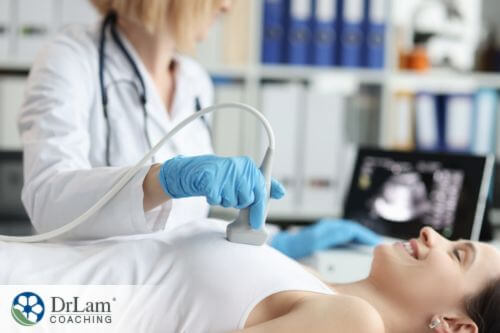 Breast health is important, so it’s helpful to know when to check in with your doctor about changes that you might have noticed related to your breasts. Consider seeing your doctor if you observe any of these changes in your breast:
Breast health is important, so it’s helpful to know when to check in with your doctor about changes that you might have noticed related to your breasts. Consider seeing your doctor if you observe any of these changes in your breast:
Instead of worrying about what these changes mean for your breast health, get an assessment from your physician. Learn what’s behind the changes and how they can be remedied.
Some breast changes may not be able to be seen or felt, but a mammogram, which is a type of breast X-ray screening, can make these changes visible. The best time to get a mammogram tends to depend on a woman’s age, overall health, existing condition, and personal preference.
Women under 40 years old aren’t recommended to have regular mammogram screenings.
In this category of women, the breast tissue tends to be denser. This means that it is more challenging to spot the difference between normal and abnormal breast tissue.
The recommendation for women 40-69 is to have mammogram screenings every two years.
If you are a postmenopausal woman and are overweight, according to research, you have a 30-60 percent higher breast cancer risk compared to women who have a healthy weight. To know if you are currently at a healthy weight, you can calculate your body mass index (BMI). You may need to make certain diet and lifestyle changes to keep your weight in check.
According to research, regular exercise seems to reduce breast cancer risk by 10 to 20 percent. The American Cancer Society’s recommendation is two and a half hours of physical activity per week to reduce your risk of developing breast cancer. You can perform moderate aerobic and resistance exercises. Some of the best types of exercises for breast health, and relief of breast cancer-related symptoms, are swimming, jogging, running, walking, cycling, weight lifting, resistance band, or HIIT. An exercise session doesn’t have to be more than 20 minutes.
Studies have shown that adherence to a Mediterranean diet was linked to a 57% reduced risk of breast cancer mortality. The intake of fibers and particularly soluble fibers, such as legumes, oat, bran, and seeds may provide protective effects. Based on studies, soluble fiber can reduce breast cancer risk by 8%. Also, consider increasing your soy intake as well, since studies have shown that the highest intake of soy (10 mg daily recommended) reduced breast cancer risk by 12%. It's important to note that the strongest effects are in premenopausal women. Furthermore, studies indicate that when your diet is supplemented with extra virgin olive oil, you can reduce your risk of breast cancer by 68%.
 The research findings from several studies indicate that for every alcoholic drink consumed a day, the relative risk of breast cancer climbed roughly 7 percent. Women should drink less than one glass of alcohol per day, while men should stick to less than two drinks per day. The key is to drink in moderation.
The research findings from several studies indicate that for every alcoholic drink consumed a day, the relative risk of breast cancer climbed roughly 7 percent. Women should drink less than one glass of alcohol per day, while men should stick to less than two drinks per day. The key is to drink in moderation.
Also referred to as menopausal hormone therapy, HRT is commonly used to alleviate the symptoms of menopause. Studies have found that some types of HRT increase the risk of breast cancer. Risk is lower if the therapy is only used for a short time. Express any concern that you may have regarding HRT with your physician. Keep in mind that HRT is different than Bioidentical Hormone Replacement Therapy (BHRT), which has a lower risk compared to HRT if done correctly.
Therapies such as chemotherapy, radiation therapy, and hormonal therapy, used to alleviate breast cancer, can also cause serious side effects. These symptoms can include cardiotoxicity, cognitive impairment, fatigue, pain, sleep difficulty, and bone loss. Furthermore, it’s common for symptoms to co-occur.
Studies reveal that Modafinil, a wakefulness-promoting agent that’s effective in managing sleep disorders and enhancing cognitive functions can alleviate symptoms related to chemotherapy in breast cancer patients. Specifically, research findings indicate that in patients receiving chemotherapy, modafinil can help to reduce severe fatigue but not mild or moderate cases of fatigue.
There is evidence that vitamin D supplementation can be used to alleviate cognitive impairment and pain (specifically joint pain) in breast cancer patients. In fact, vitamin D shows anti-neurodegenerative actions in the nervous system, while observational studies show that it increases cognitive function. Additionally, recent studies shave shown that high-dose vitamin D supplementation dramatically decreases joint pain in breast cancer patients by 88%.
Exercise can be tailored to individual breast cancer patients for the purpose of improving different side effects linked to breast cancer treatments. These include neurotoxicity, bone loss, cognitive problems, fatigue, sleep disruption, and depression, among other symptoms. Specifically, aerobic exercise and resistance exercise, done separately or combined, can help to ameliorate the symptoms of cancer-related therapies.
According to studies, breast cancer patients who undergo chemotherapy and radiation and who performed home-based walking at a moderate intensity, reduced several related symptoms. These included cancer-related fatigue, sleep disruption, depression, anxiety, and nausea.
Furthermore, other research findings suggest that breast cancer patients who did resistance exercise during chemotherapy had a boost in self-esteem. This reduced feelings of anxiety and depression. Also, patients were observed as having greater tolerance for higher chemotherapy doses.
Still, combining aerobic and resistance exercises tends to yield the best results in alleviating symptoms related to cancer therapies. These are also the best kind of exercise for not only breast cancer symptom management but for overall breast health. However, before you begin any form of exercise, talk to your physician about any concerns that you may have.
Some supplements can also help support breast health. However, be sure to talk to your physician before you start taking any supplements, especially if you have other health conditions like breast cancer or AFS.
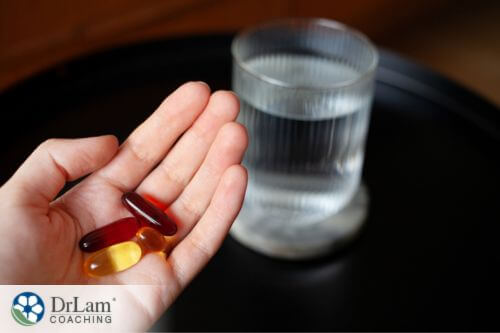 Vitamin D - As aforementioned, high vitamin D levels have been shown to reduce the risk of developing breast cancer. The recommended dose is 600 IU per day for females 14 to 70.
Vitamin D - As aforementioned, high vitamin D levels have been shown to reduce the risk of developing breast cancer. The recommended dose is 600 IU per day for females 14 to 70.Your breast health should be a priority to minimize your risk of developing breast cancer or some other breast-related issue. If you notice an unusual change in your breast and are experiencing concerning symptoms, speak to your doctor. Get a proper assessment at your healthcare provider’s office if you are unsure about the cause of a symptom.
If you are concerned about your breast health and would like assistance in determining natural ways to alleviate symptoms, the team at Dr. Lam Coaching can help. We offer a free** no-obligation phone consultation at +1 (626) 571-1234 where we will privately discuss your symptoms and various options. You can also send us a question through our Ask The Doctor system by clicking here.
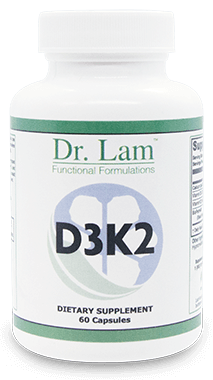
Support breast health with D5000 Plus
Risk factors linked to breast cancer include being female and over 50 years old, having a family history of breast cancer, and inheriting a faulty gene. Being overweight, drinking alcohol heavily, and getting certain types of hormone replacement therapy can also increase your risk.